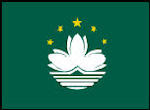Macau situa-se no Mar do Sul da China. junto à foz do Rio das Pérolas. Tendo a pesca sido urn dos mais importantes sectores do economia deste território. No passado os pescadores não tinham residência em terra, estando sujeitos a constantes ameaças, a perigos de tufões e a outros desastres naturais na sua actividade piscatória e vida quotidiana no mar. Para obter a protecção dos deuses e espíritos divinos, os pescadores passararn a prestar culto a múltiplos deuses e aos seus antepassados. Imagens de deuses protectores e de antepassados tomaram forma em esculturas, sendo estas levadas nos barcos para rituais de oração, tornando-se urn costume que fé e a prosperar em Macau o trabalho de escultura de ídolos sagrados. A partir de meados do século XX, a indústria piscatória de Macau entrou gradualmente em declínio e, consequentemente, o número de lojas que se dedicavam à escultura de ídolos sagrados diminuiu de uma dezena para as duas lojas actualmente existentes.
A producâo de esculturas de ídolos sagrados é urna das mais antigas actividades tradicionais de Macau. com mais de cem anos de história. Baseada nas técnicas tradicionais chinesas de escultura em madeira. e sofrendo naturais evoIuções com o tempo. esta actividade criou urn sistema completo de produção, desde a concepção, escolha de matérias-primas, talhe da madeira, polimento. Douramento, pintura, etc. Em Macau, inicialmente, as técnicas aplicadas na escultura de ídolos sagrados eram simples, vindo a tornar-se cada vez mais sofisticadas para satisfazer as rigorosas exigências dos clientes, especialmente dos crentes budistas. Foram adoptadas novas técnicas. corn origem em Ningbo (Provincia de Fujiang), na montagem e na produção das peças, bern como técnicas de laquear e de envernizamento, incorporando ainda técnica de aplicação de foiha de ouro usadas no Japão e em Taiwan, criando urn estilo característico de Macau. Com este conjunto de técnicas passou a ser possível a producão de esculturas de ídolos sagrados de grande dimensão.
Em 2008, o governo da RAEM, para conservar esta preciosa arte popular local. inscreveu o projecto de ‘Escultura de Ídolos Sagrados’ de Macau no segundo lote da Lista do Patrímonio Cultural Intangível da China.
As esculturas religiosas feitas em Macau incluem ídolos sagrados (Laoistas. budistas e populares). tábuas de antepassados, deuses domésticos, placas evocativas, miniaturas de templos, pagodes e santuános, e outros objectos para cerimónias religiosas. Para figurar nesta emissão de selos, foram seleccionados os seguintes ídolos sagrados:
Buda: Segundo a lenda, Siddhartha, de apelido Gautama, nascido na Índia por volta de 600 AC, era um Príncipe do Reino Shakya que, através da ascese, buscava a verdade para a salvação da humanidade, tendo os Seus ensinamentos criado uma nova filosofia. Mais tarde, foi reverenciado como Buda ou Sakyamuni, que significa “O Iluminado”, e é considerado o Supremo Buda.
Na Tcha (ou Nezha): Personagem Iendária chinesa, terceiro filho do Li Jing, um general da Dinastia Shang, responsável pela defesa da fortaleza de Chentangguan. Na Tcha sabia artes rnarciais e tinha grandes poderes. Devido a sua aparência e ao temperarnento caprichoso de uma criança, é um deus protector de crianças. Em Macau, há dois Templos dedicados a Na Tcha. Anualmente, no dia 18 de Maio do calendáno lunar, festeja-se o aniversário de Na Tcha, com cerimónias religiosas e procissões.
Kun lam: também chamada Kun Sai lam (Bodisatva Avalokitasvara), é um dos oito Bodisatvas budistas. A devoção a Kun lam na China remonta às origens do budismo na China, no sec. 1. A imagem de Kun lam não foi sempre a mesma: antes da Dinastia Song era masculina, depois passou a ter uma imagem materna e misericordiosa. E um Bodisatva muito respeitado pela população chinesa.
Tin Hau (ou A-Ma): também conhecida como Mazu (mãe ancestral). De apelido Lin, o seu nome era Moniang, natural da ilha de Meizhou, cidade de Putian, na ProvIncia de Fujiang. De acordo com a lenda, nasceu no primeiro ano do Reino Jianlong da Dinastia Song (ano 960). Foi inicialmente urna deusa dos mares, muito respeitada pelo povo, tendo mais tarde ganho também o reconhecimento de imperadores de diferentes dinastias, com atnbuição de diversos títulos, tornando-se ainda mais popular junto dos pescadores, marinheiros e comerciantes. Com as rotas marítimas da sedam a devoção a Tin Hau espalhou-se pela Costa da China até países do sudeste asiático e ao resto do mundo.
Os Oito Imortais: é uma história popular e da mitologia chinesa/taoista, sobre oito mortais que se tornaram imortais; um homem e uma muiher, urn jovem e um velho, urn rico e um pobre, um nobre e um plebeu. Até á Dinastia Ming existiam várias versões sobre as personagens desta lenda chinesa, fixando-se depois nas seguintes: Zhong Lihan. Zhang Guolao, Han Xiangzi, Tie Guaili, Lu Dongbin, He Xiangu, Lan Caihe e Cao Guojiu.
Autor: Chan leng Hin
Tradutor: Lai Jiing Liang
Direcçao dos Serviços de Correios
Woodcarving — Macao Religious Figure Carving
As an intersection of the Pearl River and
South China Sea, fishing industry was ever the most important economic industry in Macao. At the early stage. fishermen had no living places on land. As they were often attacked by typhoon and other natural disasters, fishermen had belief in more than one god and tradition of worshipping their ancestors in order to seek bless from God. They often carved the wood into a religious figure like protective god or ancestor for worship, thus, forming a custom which brought about the prosperity of Macao religious figure carving. Since the mid-20th century, the development of fishing industry in Macao began to fade and the number of shops selling religious figures reduced sharply. Now only two shops left.
With more than 100 years history, religious figure carving is one of the oldest traditional industries in Macao. It stems from China’s traditional woodcarving technique and forms a complete woodcarving process through long term development. Such process includes shape design, material selection, carving, polishing and lacquering, gilding and figure coloring. etc. The local arts and crafts of religious figure carving were simple at the beginning. However, in order to meet the strict requirements of Buddhists, the method of wood splicing used for Ningbo religious figures — ‘wood splicing”, line painting and ground coating, and gliding techniques of Japan and Taiwan were introduced. All these constitute a unique Macao carving style and a special technique which is available for super large religious figure.
In order to protect this excellent local manual skill, the “Woodcarving Macao Religious Figure Carving” was included in the second National Intangible Cultural Heritage List in 2008 upon application by the Macao SAR government.
The religious figure carving in Macao includes: religious figures from Taoism or among the people. religious figures from Buddhism. ancestral tablets, household gods. boards, temples and shrines, pagodas. and other sacrifice tools. The religious figures selected for the stamps of this issue are:
Buddha: Family name is Gautama and first name is Siddhartha. It is said that he was born in India in the 6” century B.C. and was a prince of Shakya kingdom. In order to seek and save the truth of mankind, he became a religious ascetic and created a philosophical system. He was granted the respectful titles of Buddha or Sakyamuni with the meaning of Enlightened Sage by the later generations and was the supreme god in the Buddhism.
Na Tcha: A legendary figure for the Chinese people. It is said that Na Tcha was the third son of Li Jing, the general military leader of Chentangguan in Shang dynasty and was excel in martial arts and supernatural power. As Na Tcha was presented to the public as a child, he was seen as a protective god for children. Macao has two temples to worship Na Tcha. Based on the traditional lunar calendar, May 18” is the ‘Na Tcha Festival”. During this time each year, different sacred rituals and tour activities will be held.
Kun lam: Also call the Kun Sai lam (Bodhisauva Avalokitsavara). Kun lam is one of the eight Bodhisattvas in Buddhism, during the 1st century when Buddhism was introduced to China. Kun lam became a worship figure for Chinese people. It is hard to define an exact form for Kun lam as Kun lam was presented to the public as a man in Song dynasty and as a woman with love and benevolence at the later period. Kun lam is a Buddhist Bodhisattva widely worshiped by people.
Tin Han: Also call the Mazu. Her family name is Lin and first name is Moniang. According to legend, she was horn in the first year of Jianlong (year 960) of Song Dynasty with the native place of Meizhou island of Putian city, in Fujian Province. Tin Hau had been originally the Goddess of the sea and was granted various titles by a line of kings, so she has been a popular religious figure among fishermen, sailors and businessmen. Based on the silk roads on the sea in all ages, the belief of Tin Hau was also introduced to South Asia and other places in the world from the South-East coastal area in China.
The Eight Immortals: According to the Chinese people and Taoism. this is the traditional story about eight ordinary people becoming immortals through self religious cultivation. They were people of all ages and with different status. There were many legends about the Eight lmmortals before Ming dynasty. After Ming dynasty, these religious figures were defined. They are: Zhong Lihan, Zhang Guolao. Han Xiangzi, Tie Guaili. Lu Donghin, He Xiangu, [an Caihe and Cao Guojiu.
Author: Chan leng Hin
Valor dos Selos / Stamps Value: stamps of 1.50, 2.50, 3.50 and 4.00 Patacas
Folhas Miniatura com quatro séries / Minisheets with four sets
Valor do Bloco / Souvenir Sheet Value: 1.00 Patacas
Desenho / Design: Anita, Fung Pou Chu
Data emissão / Issue date: 07.09.2010
Impressor / Printer: Österreichische Staatsdruckerei, Austria
Impressão / Print: Lithography with Varnish
Papel / Paper: Paper with Security Fibers
Picotagem / Perforation: 14 x 14































